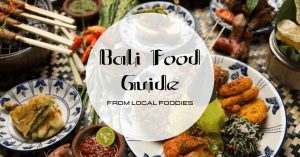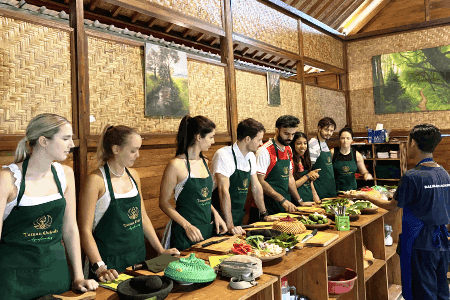12+ Must-Try Traditional Balinese Foods: Immerse in Local Culture
BALINESE FOOD INTRODUCTION
In this guide, we will take you on a journey through the vibrant world of Balinese food. From the famous “babi guling” to the traditional “nasi campur Bali” feast, we’ll show you the traditional Balinese foods you have to try to get a feel for the local culture.
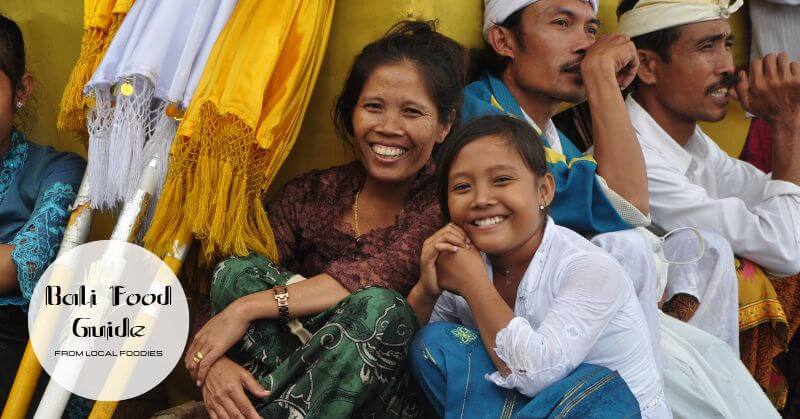
As a local foodie and tour guide, I know firsthand about Balinese food’s long history, unique ingredients, and long-held cooking traditions. In this detailed guide, I’ll tell you about what I know and love about this tasty and varied food.
So whether you’re a food lover, a traveler looking to experience the local culture, or simply curious about Balinese cuisine, this guide will provide you with all the information you need to explore and enjoy the best that Balinese food has to offer.
Let’s dive right in!
→ Immerse yourself in the sights, sounds, and aromas of our state-of-the-art hands-on cooking in “Cooking Class Ubud”
→ Our Food Guide For “Must Try” Traditional Balinese Food During Your Holiday in Bali
Balinese Cuisine Introduction

Balinese food is a unique mix of local traditions and influences from other parts of Indonesia, Chinese, and Indian cuisines.
flavors. It’s known for its bold and complex flavors that come from the use of a variety of spices and seasonings (we call it “Base Gede” that we going to talk later in this post).
Balinese food also puts a lot of emphasis on rice, which is grown using the traditional Subak irrigation system and is seen as a gift from the goddess Dewi Sri.
Influence From Other Regions
Balinese food has been influenced by Chinese and Indian cooking, among other cultures and cuisines. Chinese people brought soy sauce and other condiments to the islands, and Indian traders brought spices like cumin and coriander.
Balinese food has changed over time to include these flavors and cooking methods, making it a unique mix of different cuisines.
Food For Offerings And Celebrations
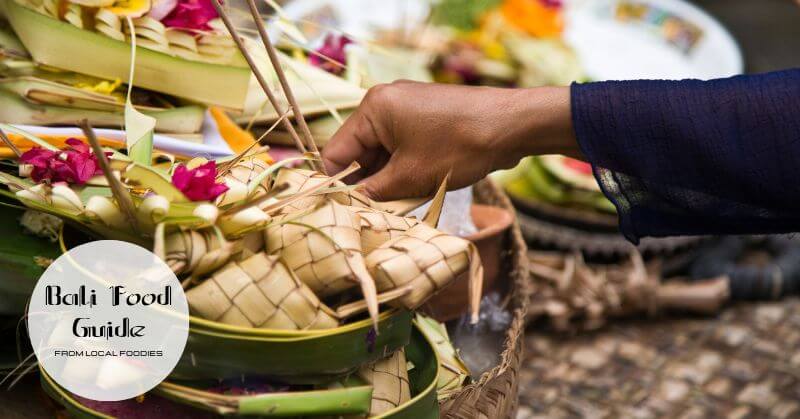
Balinese culture has a lot to do with food, and many dishes are made especially for religious ceremonies and celebrations.
For example, the popular dish Babi Guling (suckling pig) is often served at weddings and temple ceremonies.
Balinese food is more than just something to eat. It is also a way to show gratitude, respect, and devotion to the Gods and Goddess.
→ Immerse yourself in the sights, sounds, and aromas of our state-of-the-art hands-on cooking in “Cooking Class Ubud”
→ Our Food Guide For “Must Try” Traditional Balinese Food During Your Holiday in Bali
Primary Grains, Vegetables, Seafoods & Meats
Balinese food is based around rice, which is usually served with a variety of other dishes. Vegetables such as cassava, green beans, and water spinach are also widely used in Balinese cooking.
Seafood, including tuna, snapper, and prawns, is also commonly found in Balinese cuisine. Meats such as chicken, pork, and beef are typically used in Balinese dishes and are often marinated in a blend of spices and seasonings.
Balinese Cuisine Ingredients
Spices are an important part of many Balinese dishes because they add flavor and depth. Here are some of the key ingredients that make Balinese cuisine unique:

Fragrance Spices (Roots & Seeds)
Balinese cuisine is known for its fragrant spices paste which we call Base Genep or Base Gede, which include both fragrance roots and fragrance seeds.
- Fragrant seeds, also called Base Wangen (the Balinese 8-spice combination), usually contain white pepper, black pepper, coriander, cumin, clove, nutmeg, sesame seed, and candlenut.
- Fragrant roots commonly used in Balinese cuisine include shallots, garlic, greater galangal (more peppery, almost radish-like), lesser galangal or aromatic ginger (what most of us think of simply as “galangal” but it is not), turmeric, and ginger.
- Chili peppers: tiny green and red Balinese chili peppers take center stage. Larger red peppers that most of us also consider hot, the Balinese consider Sweet.
- Palm sugar: Balinese have a sweet tooth. They also enjoy combining spicy and sweet flavors. To do this, they use raw palm sugar. This is no ordinary sugar; it tastes like molasses, almost smoky. Go to the local market, and you’ll find palm sugar in a range of hues, qualities, and flavors.
Seasonings (Base Genep & Sambals)
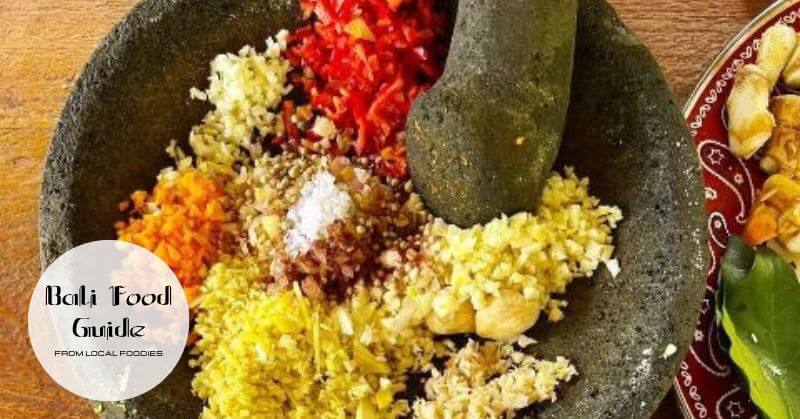
Balinese food is different from other regional cuisines because it has a unique taste that comes from the right mix of flavors. This is often achieved through the use of two main seasonings: sambal, a chili-based sauce, and basa gede, a basic spice paste.
Basa gede is made by blending fragrant seeds and fragrance roots spices I mention before. combining all those ingredients and pound it in the mortar and pestle or simply using the food processor to form it into paste like texture, along with a small amount of fish paste or shrimp paste, creating a thin paste that can be used in a variety of dishes.
Balinese cooking courses are an excellent way to gain an in-depth understanding of these key ingredients and how to use them to create the signature flavors of Balinese cuisine.
→ Immerse yourself in the sights, sounds, and aromas of our state-of-the-art hands-on cooking in “Bali Cooking Class”
→ Our Food Guide For “Must Try” Traditional Balinese Food During Your Holiday in Bali
Balinese Cuisine Traditions, Serving And Outlets
Balinese cuisine isn’t just about the food itself; it’s also about the traditions, serving, and outlets. Here are some important aspects to consider when experiencing Balinese cuisine:
Traditions

Balinese cuisine is closely tied to local traditions and culture and plays an important role in various ceremonies and rituals.
Traditional Balinese foods are often served at religious events like weddings, funerals, and temple festivals because they are thought to have spiritual meaning.
Certain dishes are also associated with specific occasions, such as Babi Guling for big celebrations or Nasi Campur for daily meals.
Serving
Balinese food is usually served as a family meal, where everyone shares a number of dishes.
The dishes are frequently served in small bowls or plates, allowing you to sample a wide range of flavors and textures in a single meal.
Balinese normally just cook the rice, vegetables or soup and meat only once in the morning let it set on the table and serve for the whole day.
Each family member come to the kitchen one by one once they get hungry and eat alone (except when there is big ceremonies or festivals they sit and eat together with the whole village or family).
In addition to family-style dining, Balinese cuisine is also known for its street food scene.
Local markets and street vendors sell a variety of traditional dishes, from the common nasi goreng (fried rice) to the more adventurous sate lilit (minced meat skewers).
→ Immerse yourself in the sights, sounds, and aromas of our state-of-the-art hands-on cooking in “Ubud Cooking Class”
→ Our Morning Cooking Class “To Explore The Traditional Market With Your Guide
Outlets

To experience the best of Balinese cuisine, there are a variety of outlets to explore. Many hotels and resorts offer traditional Balinese dishes on their menus, as do local restaurants and warungs (small family-run eateries).
In addition, cooking classes and food tours are popular ways to delve deeper into the local food culture and gain a better understanding of the ingredients and techniques used in Balinese cuisine.
MUST-TRY BALINESE DISHES
Bali’s cuisine offers a rich mix of flavors, textures, and aromas.
Whether you are a foodie who wants to try some of the best Balinese dishes or a traveler who wants to learn more about the culture, here are some dishes you must try:
1. Sate (Satay) Varieties

I really think you should try some of the tasty and different kinds of satay when you go to Bali. Satay is a common dish in Bali, and you can get it from both street vendors and fancy restaurants.
There are numerous types of satay to choose from, but there are two must-try options when visiting Bali.
→ Immerse yourself in the sights, sounds, and aromas of our state-of-the-art hands-on cooking in “Cooking Classes Ubud”
→ Our Food Guide For “Vegan Food” When You’re in Ubud
Traditional Satay Lilit (minced blend)
This dish is minced meat (beef, chicken, fish, pork, or even turtle meat) that’s mixed with fresh grated coconut, coconut milk, and bumbu bali spices.
It’s then wrapped around a lemongrass stick or bamboo skewer and grilled over charcoal.
The result is a succulent, fragrant, and slightly spicy meat that’s perfect as an appetizer or as a main course.
Satay Skewers (marinated chunk meat)
Diced or sliced chicken, goat, mutton, beef, and pork are the usual meat options for this dish, but you’ll also find satay that’s made with fish, tempeh, tofu, eggs, or a combination and grilled over charcoal.
Spices are used to marinate satay skewers, which are then served with rice cakes, peanut sauce or chili tomato sambal, and a fresh cucumber.
No matter where you decide to try satay in Bali, you’re sure to be delighted by the rich flavors and unique spices that make this dish so special.
So don’t miss the opportunity to try these two must-try satay varieties during your culinary journey in Bali.
2. Babi Guling or Roast Suckling Pig
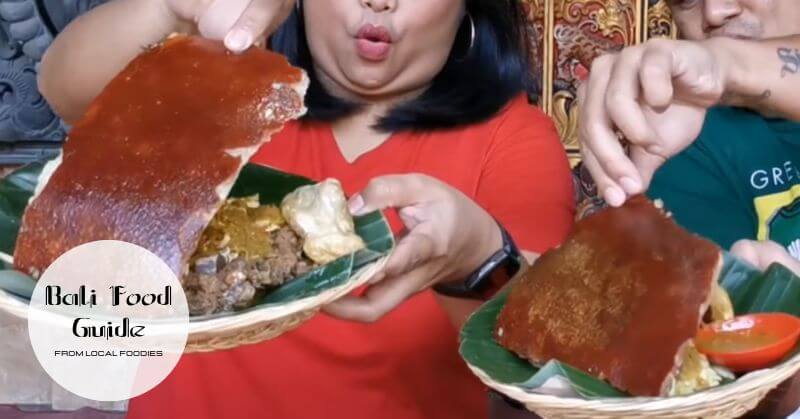
Babi guling is a must-try dish when in Bali if you are not vegetarian or vegan, as it is a Balinese specialty that’s often served at traditional ceremonies and celebrations.
But don’t worry, you don’t have to wait for a ceremony to try this delicious dish. You can find it at local warungs or restaurants, especially in Ubud.
One of the most famous and legendary places to try babi guling in Ubud is Ibu Oka Babi Guling. and there is one that become phenomenal right now is Babi Guling Genteng Jumbo (Check this video review from Bali Foodie here )
This famous Balinese dish is roasted suckling whole pig that has been marinated in a mixture of Balinese spices or bumbu bali. The meat is tender and full of flavor.
The pig is then slow-roasted until the skin is crispy and the meat is juicy and tender. Babi guling is usually served with steamed rice, lawar, and a spicy sambal that adds a kick to the dish.
Be sure to add some crispy skin to your plate for an extra burst of flavor.
Don’t miss out on this iconic Balinese dish during your visit to Bali!
→ Immerse yourself in the sights, sounds, and aromas of our state-of-the-art hands-on cooking in “Cooking Classes Ubud”
→ What We Grow on The Farm? Check here “Our Organic Farm Produce
3. Gado-Gado
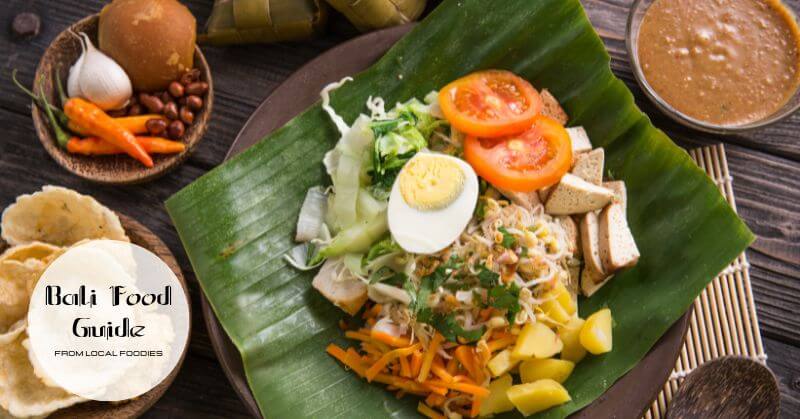
Gado-gado is a popular Indonesian and Balinese dish that is loved by locals and tourists alike.
The dish is made with a variety of steamed or blanched vegetables, such as bean sprouts, spinach, cabbage, and long beans, mixed with boiled potatoes, fried tofu and tempeh, and hard-boiled eggs.
The salad is then dressed with a creamy, nutty peanut sauce and often served with krupuk (crispy crackers) and shrimp chips.
The peanut sauce used in gado-gado is made with a blend of ground peanuts, garlic, shallots, aromatic ginger, palm sugar, and chili and is an essential element of the dish.
The vegetables and protein are then put on a plate, and the sauce is poured on top. This makes a flavor explosion that is both delicious and satisfying.
Gado-gado is a healthy and flavorful Balinese vegetarian dish and is often enjoyed as a light lunch or snack.
It’s commonly found at local warungs, street food stalls, and restaurants
and is a must-try for anyone looking to experience the diverse and delicious flavors of Balinese vegan cuisine.
4. Nasi Campur Bali
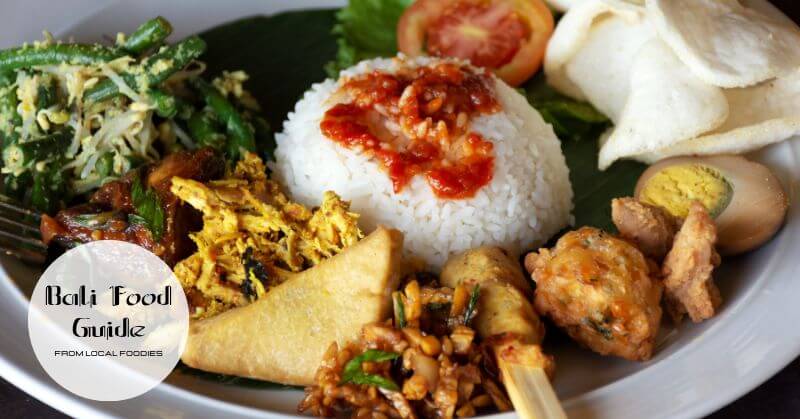
Nasi Campur Bali is the perfect dish for those who want to experience a mix of flavors and textures that are unique to Balinese cuisine.
It’s a rice dish that comes with a variety of sides, like babi guling (Balinese roasted suckling pig) or betutu (spiced chicken or duck), mixed vegetables, and a dash of spicy sambals.
This dish is a staple in local warungs (small restaurants) and restaurants alike, and it’s often served during special occasions and ceremonies.
The mix of flavors and textures in Nasi Campur Bali really captures the essence of Balinese food,
and anyone who wants to learn more about the local food culture should try it.
5. Betutu (Chicken or Duck)

Betutu is a must-try dish for anyone visiting Bali. Betutu is a traditional Balinese dish made by baking chicken or duck in a fire husk, giving the dish a unique flavor.
The meat is slowly cooked in palm leaves with a spice mix or bumbu bali, resulting in a tender and flavorful meat that is sure to satisfy.
This dish is often served with a side of plecing kangkung, crispy-fried peanuts, and sambal terasi.
The traditional way of making betutu takes time and patience (from 4 hours to 8 hours), but it is worth it for the delicious and authentic Balinese flavors that it offers.
So if you’re looking for an authentic Balinese experience, be sure to try Betutu, one of the island’s most famous dishes.
6. Tum or Pepes

Tum or Pepes is a dish that everyone who wants to try authentic Balinese food must try. This dish can be made with a variety of ingredients, including ground meat, tofu, vegetables, and other proteins such as pork and beef.
The ingredients are mixed with an aromatic blend of Balinese spices or bumbu bali and then wrapped in banana leaves before being steamed or grilled.
This cooking method allows the ingredients to cook and infuse with the flavors of the spices, resulting in a tender and flavorful dish that’s perfect as a snack or as a side dish.
Tum, or Pepes, is a popular street food in Bali and can be found in many local warungs and markets.
7. Lawar

Lawar is a must-try dish in Bali that is typically made of various fresh vegetables such as fern tips, young papaya, and jackfruit, add some fragrance kaffir lime leaves, fresh grated coconut, and sambal goreng (which is a combination of fried shallots, chilies, and shrimp paste).
Add with some protein to the dish, minced chicken, pork, lamb, beef, or duck that are marinated with Bumbu Bali, a Balinese spice paste, and cooked with coconut milk.
What makes Lawar unique is that it is named based on its protein ingredients. For instance, if it contains chicken, it is called chicken lawar; if it contains pork, it is called pork lawar; and if it contains young jackfruit, it is called jackfruit lawar.
However, some variations of Lawar might include the blood of butchered animals, usually pork or chicken, mixed with spices to enhance the taste.
Due to its high protein and fat content obtained from coconut milk and blood, Lawar spoils easily and should be consumed immediately. It is typically good for only half a day before going bad.
Don’t miss the chance to try this unique and delicious dish during your trip to Bali.
8. Seafood (Jimbaran Style)

As a seafood lover, you simply can’t miss out on the Jimbaran-style seafood in Bali. This delectable dish is a feast for the senses and a must-try for anyone visiting the island.
Jimbaran-style seafood typically features an array of grilled seafood such as fish, prawns, squid, crabs, and more, all marinated with an aromatic blend of Balinese spices that are sure to tantalize your taste buds.
The dish is typically served with steamed rice, mixed vegetables, and sambals, which add depth and balance to the flavors of the grilled seafood.
The best place to enjoy this delightful dish is at a local seafood market restaurant located along Jimbaran Beach.
It’s best to go there in the afternoon or early evening so you can enjoy the food while watching a beautiful sunset.
Trust us: You won’t regret trying this dish during your visit to Bali!
9. Sambals

Sambal is an essential part of our food culture. It’s a chili-based sauce that adds a burst of flavor and heat to our dishes.
In Bali, sambals are used to add complexity to the taste of a dish rather than just pure spiciness.
We have a variety of sambals, each with its own unique flavor and heat level.
- One of the most popular sambals in Bali is sambal matah, which is made with shallots, lemongrass chili, and coconut oil. It’s a fresh and fragrant sambal that’s perfect for fish and grilled meats.
- Another famous sambal is sambal bejek, made with chili, tomato, and shrimp paste. It has a rich and bold flavor that pairs well with seafood and vegetables.
- Sambal terasi is another popular sambal that is made with chili and shrimp paste. It’s a more pungent sambal that’s perfect for grilled meats and vegetables.
- Sambal kecombrang is another unique sambal that uses torch ginger, shallots, and chili. It has a refreshing taste that pairs well with seafood and grilled meat.
- Lastly, sambal mbe is a simple version of sambal that only has fried shallots for people who like a milder flavor.
10. Traditional Cakes and Desserts

Balinese desserts are the perfect way to end a meal on a sweet note. Made with local ingredients like coconut, palm sugar, and rice flour, these desserts are a treat for the taste buds.
- One dessert you have to try is klepon. It is made of small balls of glutinous rice flour that are filled with palm sugar and covered in grated coconut.
- Another classic dessert is jaja ketan, a sweet rice cake that’s often topped with coconut shreds, which add a slightly nutty and sweet taste to the dessert.
- If you’re looking for something more indulgent, you can try dadar gulung, a crapes made with rice flour, coconut milk and filled with cooked coconut mixed with palm sugar that is a crowd favorite.
- Other popular Balinese desserts include bubur sumsum, a coconut white rice porridge, pudding texture a like top with palm sugar syrup.
- batun bedil, glutinous rice flour dumplings in brown sugar sauce,
- laklak, a Balinese pancake made of white rice flour top with fresh grated coconut and palm sugar syrup.
- and bubur injin, a black rice pudding with coconut milk and palm sugar.
These desserts are readily available at local warungs, market and restaurants and are the perfect way to end a Balinese culinary adventure.
11. Street Savory Snacks (Tempeh & Tofu)

In Bali, you can find many street snacks that are made from tempeh, tofu, banana and other ingredients.
- Fried tempeh, tempe is a cake made from fermented cooked soybeans that is used a lot in Balinese food and Indonesian. It tastes nutty and has a firm texture. It’s often deep-fried and served with sambal or sweet soy sauce or fresh hot chili, making it a popular snack for vegetarians and non-vegetarians alike.
- Tofu is also a common ingredient in Balinese street snacks and can be deep-fried and served with sambal or hot chili. In Bali, you can find more vegetarian street food than just tempeh and tofu.
- Banana fritters are a popular snack made by deep-frying ripe bananas that have been coated in batter.
- Fried tape, which is made from fermented cassava, is another popular snack that’s crispy on the outside and chewy on the inside.
- Bakwan is a savory snack made from a mixture of vegetables, flour, and spices that’s deep-fried until crispy.
These snacks are perfect for those who want to try something new and explore the unique flavors of what Balinese eat for snacks.
12. Soups (Bakso & Ares)

Bakso is a beloved Indonesian meatball soup that can be found all over Bali. Made with ground beef or chicken, the meatballs are mixed with various spices and then boiled in a flavorful broth made with herbs, garlic, and shallots.
- Bakso, served with a mixture of noodles, vegetables, and toppings, is a hearty and filling dish that’s perfect for a quick lunch or snack.
- Another must-try soup in Bali is Ares, which is a unique soup made with young banana stems, jackfruit, and either chicken, pork, or duck (or beans for a vegetarian version). It is a dish that is often served at traditional Balinese ceremonies. It has a rich flavor that is both refreshing and filling.
- Balung is another popular slow-cooked Balinese pork dish made with pork ribs, bumbu Bali, and other aromatic spices. It’s a rich and flavorful soup that’s perfect for warming up on a chilly day.
- Soto babi is a traditional Indonesian soup that’s made with pork, bean sprouts, and a flavorful broth that’s spiced with bumbu bali paste. It’s often served with rice or noodles and can be found at local warungs throughout Bali.
- Jukut Undis is a vegetable soup that’s made with black beans, coco, and a blend of herbs and spices. It’s a vegetarian-friendly option that’s full of flavor and texture and is often served with rice for Balinese.
13. Nasi Goreng or Mie Goreng
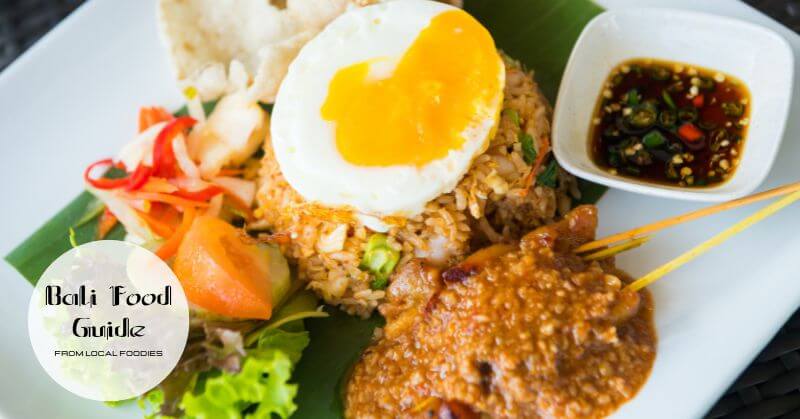
Nasi goreng and mie goreng are two of the most popular dishes in Bali.
Nasi goreng is a fried rice dish that’s made with a mixture of spices, vegetables, and meats, such as chicken, pork, or shrimp. The dish is stir-fried in a wok with garlic, shallots, and chilies, giving it a spicy and savory taste.
Mie goreng, on the other hand, is a fried noodle dish that’s made with egg noodles, vegetables, and spices, and can also include meats such as chicken or pork.
Both nasi goreng and mie goreng are usually served with a fried egg on top, adding a rich and creamy texture to the dish.
These dishes are perfect for those looking for a quick, delicious, and satisfying meal, and can be found at local warungs or high-end restaurants.
BONUS: Herbal Tonic “Jamu”
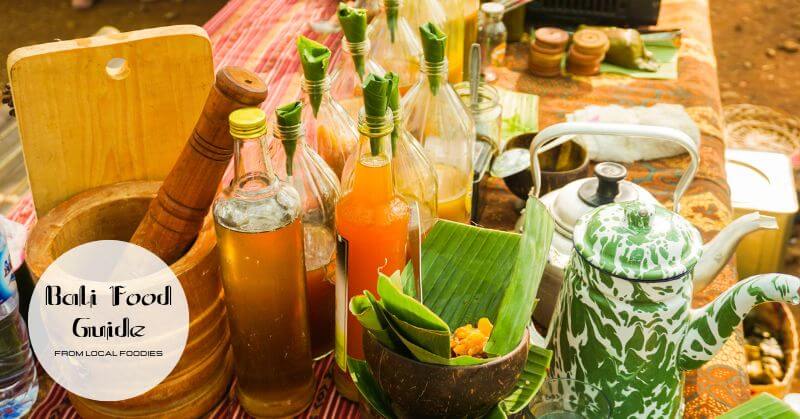
Jamu is a traditional Balinese herbal drink that has been used for centuries for its medicinal properties.
The drink is made from various natural ingredients, such as roots, leaves, fruits, and seeds, that are blended together and then strained to create a tonic.
Jamu is thought to help with a number of health problems, such as digestive issues, headaches, and low energy. It is also believed to have anti-inflammatory and anti-aging properties.
There are various types of jamu, each with their own unique set of ingredients and health benefits.
Some popular types of jamu include Kunyit Asam (tamarind and turmeric), Beras Kencur (aromatic ginger and rice), and Temulawak (Javanese ginger).
In Bali, you can find jamu sold by street vendors or in health food stores. It’s also possible to attend a jamu-making class and learn how to create your own customized blend of jamu.
Jamu is a great way to not only immerse yourself in Balinese culture but also take care of your health in a natural way.
Conclusion
As we come to the end of this guide, we hope that you have gained a deeper appreciation for the rich and diverse flavors that make Balinese cuisine so unique.
From the mouthwatering sate varieties to the succulent babi guling and the colorful nasi campur Bali, each dish offers a taste of the local culture and tradition.
We hope that this guide has inspired you to try out these traditional Balinese dishes, and to seek out the many other culinary delights that this vibrant island has to offer.
Whether you’re a foodie or simply looking for a delicious meal, Balinese cuisine is sure to tantalize your taste buds and leave you with a lasting impression of the warmth and hospitality of the Balinese people..
Which of these must-try dishes are you most excited to try? Have you tried any Balinese food before, and if so, what did you think?
Share your thoughts and experiences with us in the comments below. And if you have the opportunity to visit Bali, we encourage you to immerse yourself in the local food scene and try as many traditional Balinese dishes as you can. Happy travelling!

